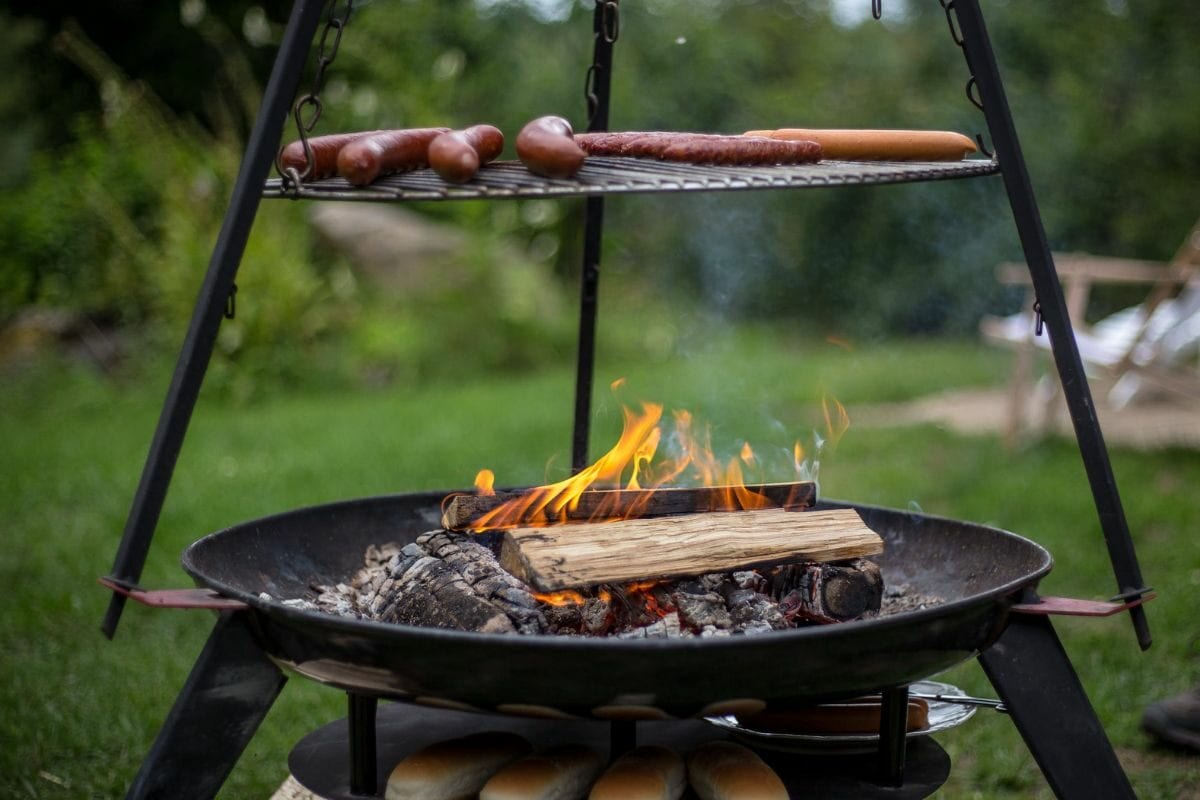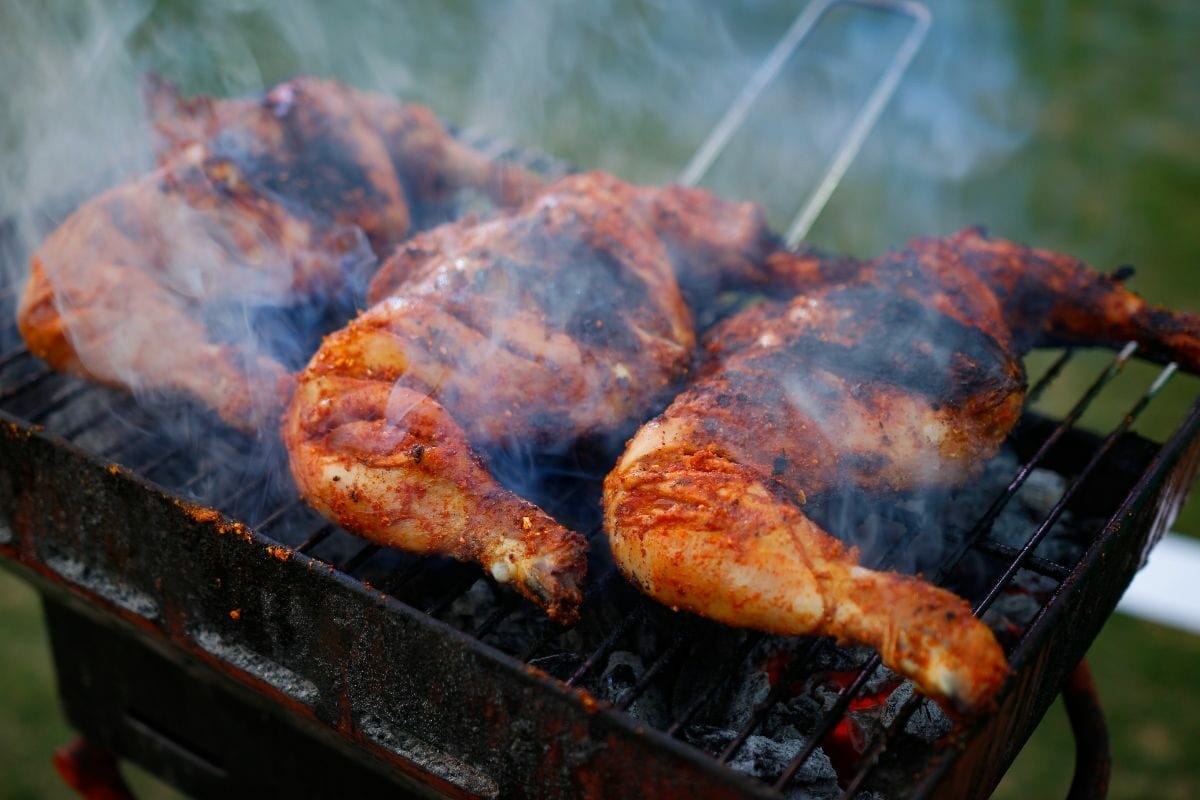Building a smoker is not rocket science! Get your hands on a metal barrel that’s free from hazardous substances. Whip out a drill, punch out vent holes, then toss in a charcoal basket down below, ensuring it fits in snugly. Next, plop a cooking grate right on top of the basket and drill a thermometer through the lid to keep tabs on the cooking temperature.
As a die-hard fan of lip-smackin’ smoked treats, I ventured on a quest to build my own backyard smoker. I’ll tell you this. You haven’t truly arrived as a pitmaster until you can proudly claim you built your very own “BBQ pit.” I converted a steel drum into what’s known as an “ugly drum smoker.”.
So grab your tools, roll up those sleeves, and dive headfirst into the wonderful world of smoker construction.

Safety first! Before you bring home a potential drum for your barrel smoker, ensure it’s a food-grade steel drum. We don’t want nasty chemicals or hazardous substances ruining our smoking game.
Keep an eye out for any labels or markings that say it’s good for storing or handling food or not. Give it a thorough inspection and make sure it’s clean and safe to use. If you can’t find any indicating labels, you can try asking a local health department employee to check whether this is safe to use or not. We want our smoked food to be delicious, not contaminated.
The best way to make sure your drum doesn’t hold anything toxic is to buy a new one. Don’t buy a drum with a drum liner. Drum liners are chemical liners and are extremely difficult to remove.
Building your own ugly drum smoker involves using power tools. Wear appropriate eye, respiratory, and hearing protection. You’ll want a good pair of work gloves, too – metal can be sharp.
Want to have your own smoker and start smoking without breaking the bank? It’s time to give that drum a makeover and turn it into a kick-butt homemade smoker! Here’s the lowdown on how to make it happen.

First, you need to hunt down a steel drum that hasn’t been hanging out with toxic stuff. Start by scoping out your backyard or taking a stroll through the neighborhood. Keep your eyes peeled for those hidden drums lurking behind garages or forgotten in corners. Craigslist and Facebook Marketplaces are good spots to check, too.
Check recycling centers or give industrial supply stores a shot. Sometimes, you might just stumble upon the perfect drum in the most unexpected places. Buy a new 55-gallon drum here.
Once you find one, ensure it meets all the safety precautions mentioned earlier. You want a drum with no drum liner and one that doesn’t hold anything toxic or nasty.
Strip that drum down to its bare essentials. Remove any handles that are cramping your style. Don’t remove the lid, though. It will serve as the DIY smoker lid.
Then, strip it inside out of rust, paint, or oxidation with an angle grinder. This is a dirty, loud, and long chore.
Watch the video below to see how it’s done:
To keep things smoking just right, it’s time to drill some air vents. Grab a drill with a hole saw attachment. A set like this from Milwaukee will work. Make sure the bits are for drilling into metal. Hole saws designed for wood won’t punch through metal. A step bit designed to drill metal also works.
We’ll be creating a series of holes around the drum for air intake.
Drill 2 1” holes at the bottom of the drum. These will allow air to feed the coals. You can buy and install dampers to regulate the airflow.
We’ll end with the drum cover. Drill one 2” hole close to the perimeter of the lid. Remember, air circulation is the name of the game! You can use aluminum foil as a damper, or buy a damper online or at the hardware store. Mount it over the hole.
Note: The vent hole and spacing instructions I gave assume you’re working with a 55-gallon drum that has a diameter of around 22.5 inches. So if you’ve got something smaller, you might need to adjust.
Grab four equally-sized bricks, and put them in the bottom of the smoker. Get fire bricks. They can withstand higher temperatures. Other bricks might crack or even explode. Go to a nearby fireplace or specialty brick store if the box stores don’t have fire bricks.
With the bricks in place, we’ve set the stage for our next move – the almighty charcoal basket. For now, take a step back and admire your brickwork. It’s like the foundation of a smoking empire!
Want something that fits perfectly into your old drum? Go for a charcoal basket like this Kick Ash Charcoal Ash Basket. Or find a grate that fits perfectly inside the drum.
But since we’re all about getting creative with a homemade smoker, you can fashion yourself a DIY charcoal basket. No need to splurge at the store. We’re making this from scratch! Use stainless steel. It lasts forever and won’t rust.
You can make a charcoal basket from some expanded metal – you can bolt it together, so you don’t need to weld anything. Aim for around 22 inches in diameter or thereabouts. Just so you know, regular steel drums measure around 22.5 inches in diameter. We want a basket that fits in snugly and securely.
Check out this video to see how to make a DIY charcoal basket for your drum smoker out of expanded metal:
Once your charcoal basket is ready to roll, place it on top of those trusty bricks in the drum.
First, grab some stainless steel racks or raid your kitchen for oven grates begging for a new purpose in life. You can even double a stretch of expanded metal and use that as a rack. You want to avoid rusted metals. Clean it up if needed.
Now, here’s the trick: we want those grates to fit snugly in the drum without any wobbling or sinking shenanigans. Ain’t nobody got time for shaky grates messing with our food.
So, here’s what you have to do: adjust the height of the grates in the cooking chamber to your liking, making sure they’re stable and secure. You can use metal brackets or wire to secure them in place.
If you’re going for the wire method to secure those cooking grates, I’ve got a little trick for ya.
Grab your trusty drill and punch two holes at each point where you want to introduce the wires.
Why two holes, you ask? Well, that’s how we’ll lock in those wires and keep them from slipping and sliding.
Note: While wires work for some people, I think they’re not ideal. They seem janky to me. I recommend going for sturdy right-angled metal brackets like the Fatloda Stainless steel brackets. They work like a charm for both single and multilevel rack systems.
Pick a drill bit of the same size as the thermometer stick. Pick a convenient spot, drill a small hole, and attach a thermometer to your drum. This is so you can keep tabs on that smokin’ hot temperature.
Something like the PatioGem Grill Temperature Gauge works fine here.
Or, skip the mounted thermometer and grab a Thermoworks Smoke. It’s incredibly accurate. Here’s the deal: when it comes to multilevel DIY smokers, you know the temp at the top rack will be lower than the bottom one. The Themoworks smoke will allow you to track temps at each rack (the lower rack is closer to the fire and hotter), as well as your food temperature. Boom!
Stick one thermometer at the bottom rack level to monitor the heat down low. Then, pop another thermometer at the top rack level or through the lid to keep an eye on the overall temperature at the top level. This way, you’ll have a clear picture of how the heat’s flowing and make adjustments as needed.
Before you start cooking on the drum, clean it thoroughly with a food-safe cleaner. This can be warm water and a little squirt of dish soap. Take a sponge or cloth and dip it in the soapy water. Scrub away at the inside of the drum until it’s squeaky clean. Once you’ve worked your magic, rinse the drum well to remove any soapy residue.
And once you’re done building the smoker, you may choose to paint that drum with heat-resistant and food-safe paint. Something like the Rust-Oleum High Heat Spray Paint works for this. This is not just to give your drum smoker some flair. It will also prevent it from rusting.
Finally, you have to season your new homemade ugly drum smoker! This helps to eliminate any manufacturing odors and creates a non-stick surface. Give the interior surfaces a good coating of non-stick seasoning oil. You can also use vegetable oil.
Add charcoal and fire it up at a moderate temperature (300°F) for a few hours. Bam, Your smoker is seasoned and ready to christen with your first smoke.
Time to add your personal touch! You could slap on and drill in some handles for easy moving and grooving. And if you really want to amp up the game, insulate that drum with high-temperature insulation tape made of aluminum foil. This helps to keep the smoking heat where it belongs! Maybe you want to add casters so it moves easily. The sky is the limit.
You can watch the YouTube video below to see what your ugly drum smoker should be like:
Looking to make an offset smoker? I’ve got you! Start by checking out how to find a drum that’s safe to use. Then clean it up. These were mentioned earlier in Steps 1 and 2 of the previous instruction before proceeding.
Take your trusty jigsaw or reciprocating saw and cut off ¼ of the drum. Use a metal blade – they have finer teeth than blades used for cutting wood. But wait! You’re not slicing everything into two halves.
We’re cutting out just the lid for the offset smoker. For illustration’s sake, the video below shows the size and how to cut the lid out:
Attach two hinges to one side of the drum. These will mount to the drum and the lid. These hinges will allow you to open and close the lid effortlessly, giving you easy access to your food. Secure them with screws or bolts for a sturdy setup.
Get an exhaust damper at your local hardware store, or order this Stanbroil pellet grill damper. Grab your drill and a circular bit (a 3½-inch hole saw attachment). Aim for a big hole on one side of the drum where the air can flow freely. I’m talking about a 3½ inch diameter hole, assuming you got the Stanbroil damper mentioned above. The damper will go on the side opposite the firebox.
But if you have something else and you want to be precise, measure the damper’s hole diameter and match it with the right hole saw attachment.
Next up, it’s bolt time! Drill a few small holes to attach the exhaust damper. Once you’re done with that, slap that exhaust over the hole you just drilled and secure it tight with bolts and nuts. Voila! Your damper is ready
Now, here comes the fun part. Open it up, close it down, and adjust the damper as needed to control the airflow and regulate the temperature inside your DIY smoker. It’s like being the conductor of a smoke symphony!
Install a temperature gauge on the side of the drum. This handy tool will help you monitor the temperature inside the smoking chamber. Drill a hole, insert the temperature gauge, and secure it. Now, you’ll have precise control over your smoking game.
You’ll need another smaller drum to mount to the side of the smoker. This will be your firebox.
The drum needs to be big enough to hold 4 or 5 pieces of wood. It will sit lower than the cooking chamber. Cut a hole on one end, and cut a matching hole on the 55-gallon drum. Mount the firebox to the cooking chamber with screws or bolts, or weld it in place.
Alright, it’s time to give your DIY smoker the support it deserves!
You can find pre-made legs at your local hardware store. Or, if you’re feeling extra crafty, you can even fashion your own legs out of metal rods or pipes.
Once you have them, it’s time to get them attached. Flip that drum over and position the legs evenly around the bottom.
To fasten, use a welder, screws, bolts, or whatever you’ve got on hand to attach the legs to the bottom of the drum securely. You don’t want any wobbly business when you’re cookin’ up a storm!
Give those legs a little shake to ensure they’re sturdy and can handle the weight.
And there you have it! Your DIY smoker now stands tall, lifted off the ground by those sturdy legs.
If you feel like jazzing up the outside, spray the entire smoker inside and out, including the legs, with food-safe paint. Remember, I mentioned it in Step 8 of the previous process for the barrel drum smoker. Make sure it’s high-heat paint.
That’s how to build an offset drum smoker if you’re a starter. But if you need a guide to visualize the process, check out the YouTube video in Step 1.

If the metal drum isn’t your style or you’re looking for some smaller alternative options, check out these cool options:
Ever thought of turning a propane tank into a badass offset smoker? Check it out:
Check out the video below if you need a more detailed guide:
You can transform a simple trash can into a wicked cold smoker using a hot plate.
You can build on the whole procedure I showed you by watching the YouTube video below. But note that this one doesn’t involve the use of a hot plate:
Who would’ve thought a boring filing cabinet could moonlight as a legit DIY smoker? It’ll definitely turn heads and make your buddies go, “Whoa, dude, you’re smoking meat in an office cabinet? That’s wild!” Here’s the low-down:
Meanwhile, if you don’t have a hot plate, check this video below to see how you could make a file cabinet smoker without one:
To wrap up, making your own DIY smoker is an excellent way to level up your grilling skills without breaking the bank. Whether you’re turning an old steel drum, repurposing a propane tank, or getting creative with a metal trash can, the possibilities are endless. Clean it up, tweak it, and add those vents, racks, and temperature gauges like a boss.
Each step gets you closer to the ultimate smoking machine. Just remember to play it safe and pay attention to the details. So grab your gear, get your hands dirty, and have fun DIYing and smoking!